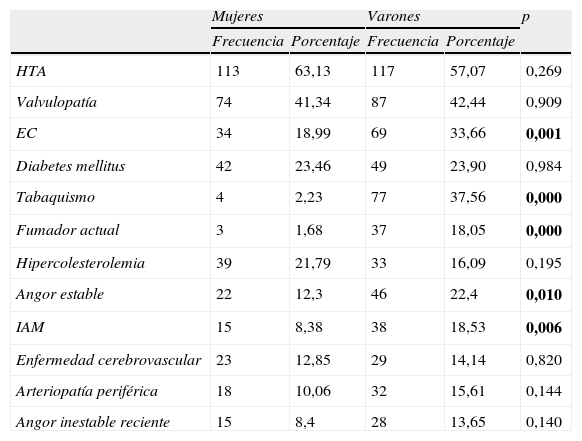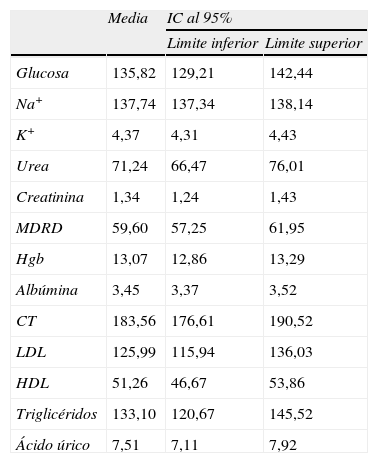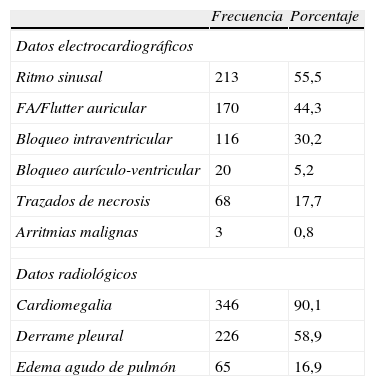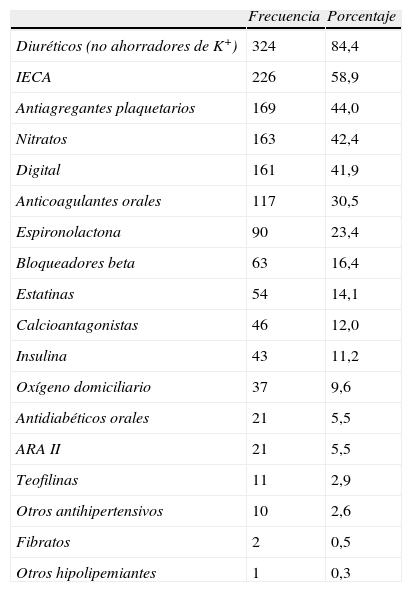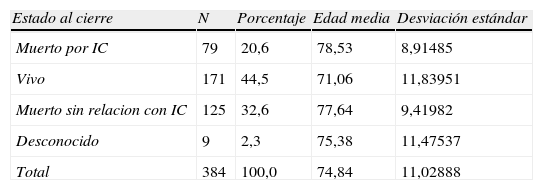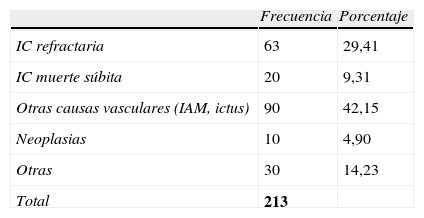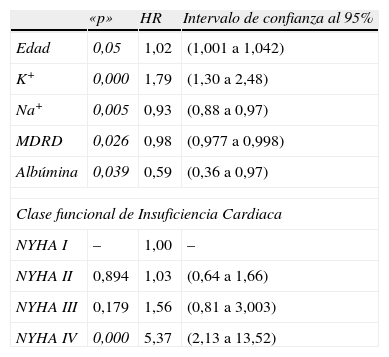La insuficiencia cardíaca (IC) supone un importante problema de salud pública, tanto por su elevada morbimortalidad como por el alto coste sanitario que provoca. Se realiza este estudio para estudiar la supervivencia de pacientes con IC en relación con la función ventricular y otros posibles factores de riesgo (FR) asociados con el pronóstico de la IC.
Material y métodosEstudio de cohortes, prospectivo, considerando como potenciales participantes a cualquier paciente hospitalizado por IC entre el 1 de enero de 1999 y el 31 de diciembre de 2002 (5.318 pacientes), a quien se le hubiese realizado ecocardiografía que mostrase disfunción sistólica ó diastólica (2.387 pacientes). Se eligió por muestreo aleatorio simple una muestra de 384 pacientes, transcurridos al menos 24 meses tras el episodio índice de hospitalización. La medición principal residió en la supervivencia y en las diferencias observadas en función de la fracción de eyección del ventrículo izquierdo, de la clase funcional (CF) de IC y de otras características clínicas y epidemiológicas. Se utilizaron las pruebas de Kaplan-Meier, del log-rank y de Cox.
ResultadosLa edad media fue de 74,84 años (rango: 36–95). 53,4% varones y 56,5% primer ingreso. El antecedente personal más frecuente fue hipertensión arterial (HTA) (59,9%), seguido de valvulopatía (41,9%) y enfermedad coronaria (EC) (26,8%). El 44,3% presentaban fibrilación-flutter auricular (FA). La supervivencia global observada a los 5 años fue de 47,9% y la específica por IC de 74,8%. No hubo diferencias significativas en supervivencia entre pacientes con insuficiencia cardíaca y función sistólica preservada (IC-FSP) y aquellos con disfunción sistólica (p=0,248). Son factores pronósticos de mortalidad por IC la CF basal previa al ingreso avanzada (Hazard ratio (HR) 5,37), el deterioro de filtrado glomerular (FG) (HR 0,98), la hipoalbuminemia (HR 0,59), la hiponatremia (HR 0,93), y la hiperpotasemia (HR 1,79). El índice de Castelli superior a 4,5 se halla en el límite de la significación estadística.
ConclusionesLa supervivencia global observada a los 5 años es similar a la de otras series publicadas, siendo la específica por IC algo inferior, no habiendo diferencias en la supervivencia respecto a la fracción de eyección del ventrículo izquierdo (FEVI). Destacan como factores pronósticos de mortalidad por IC la hipoalbuminemia, la hiperpotasemia y el índice de Castelli elevado.
Heart failure (HF) is a serious health problem in Spain because it has a high mortality rate and causes considerable costs to the health-care system. This paper presents a study made in the Spanish province of Ourense to study the survival of patients with HF related to the ventricular function or other possible risk factors (RF) associated with the HF prognosis.
Material and methodsA prospective cohort study was performed, considering any patient hospitalized due to HF from 1 January 1999 to 31 December 2002 (5318 patients) who had undergone an echocardiography that showed systolic or diastolic dysfunction as potential participants (2387 patients). After at least 24 months of the index episode of hospitalization, a sample of 2384 patients was chosen by random sampling. The principal measurement was based on survival and the differences observed in the performance of the left ventricular ejection fraction, of functional class (FC) of HF and of other clinical and epidemiological characteristics. The Kaplan-Meier, log-rank and Cox tests were used.
ResultsMean age of the patients 74.84 (range 36–95); 53.4% males and 56.5% first admission. The most common antecedent was arterial hypertension (HTA) (59.9%), followed by valvulopathy (41.9%) and heart disease (HD) (26.8%). A total of 44.3% of the patients had atrial fibrillation-flutter (AF). Global survival at 5 years was 47.9% and specific survival rate for HF was 74.8%. There were no significant differences in survival between patients with heart failure and preserved systolic function (HF-PSF) and those who suffered systolic dysfunction (p=0.248). Prognostic factors of mortality in patients with HF are: advanced functional class (class III–IV) prior to admission (Hazard ratio [HR] 5.37), deterioration of the glomerular filtration rate (GFR) (HR 0.98), hypoalbuminemia (HR 0.59), hyponatremia (HR 0.93) and hyperkalemia (HR 1.79). The Castelli index higher than 4.5 is in the limit of statistical significance.
ConclusionsGlobal survival rate observed at 5 years of research is similar to the results found in already-published papers. Specific survival rate for HF is lower and there are no differences in the survival rate with regard to the left ventricle ejection fraction (Ef). However, we show that hypoalbuminemia, hyperkalemia and high Castelli index are important prognostic factors of mortality in patients with HF.
Article
Diríjase desde aquí a la web de la >>>FESEMI<<< e inicie sesión mediante el formulario que se encuentra en la barra superior, pulsando sobre el candado.

Una vez autentificado, en la misma web de FESEMI, en el menú superior, elija la opción deseada.

>>>FESEMI<<<





